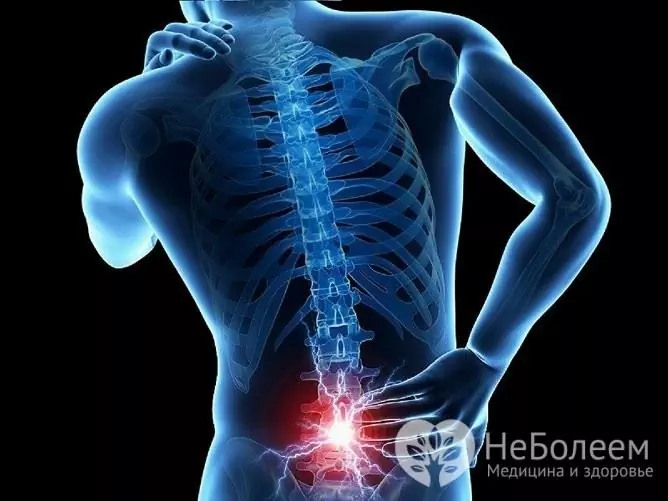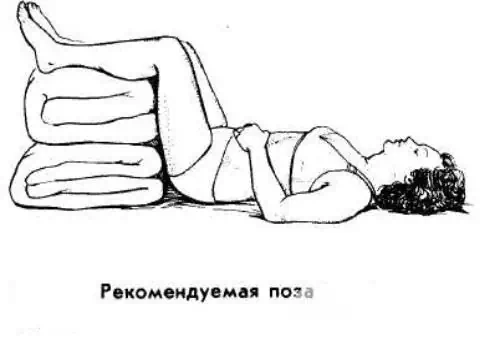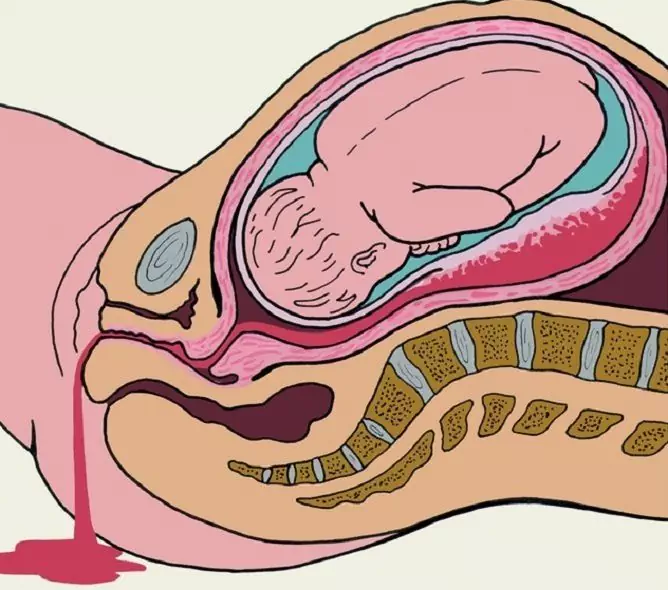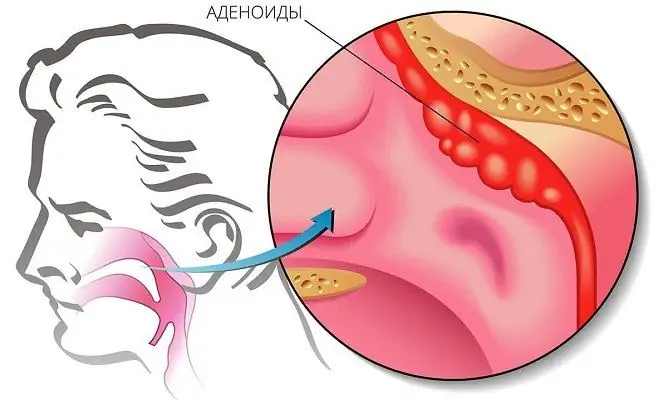- Author Rachel Wainwright [email protected].
- Public 2023-12-15 07:39.
- Last modified 2025-11-02 20:14.
Lumbago
The content of the article:
- Causes
- Lumbago symptoms
- Diagnostics
- Lumbago treatment
- Prevention
- Possible consequences
Lumbago is a pain syndrome characterized by severe pain in the lumbar region ("lumbago"). More often observed in men in the age of 30-40. An attack of pain with lumbago occurs acutely and lasts from several minutes to several hours. Lumbago should be distinguished from lumbodynia, in which pain in the lumbar region persists for a longer time and lumboishalgia, when pain is localized in the lumbar region and radiates to the leg.
Causes
Pinching or irritation of the nerve roots extending from the spinal cord in the affected segment leads to the development of lumbago. The resulting pain provokes, in turn, reflex muscle spasm, which leads to even greater compression of the nerve root and increased pain.

Source: nazdor.ru
In more than 90% of cases, the cause of lumbago is osteochondrosis and its complications in the form of intervertebral hernias. In other cases, an acute attack of pain in the lumbar region can be caused by the following pathological conditions:
- congenital anomalies in the structures of the vertebrae - splitting of the arches, an accessory lumbar vertebra (lumbarization), an accessory sacral vertebra (sacralization);
- disorders of the structure and shape of the intervertebral joints;
- violations of the shape of the vertebrae - wedge-shaped, butterfly-shaped;
- violations of the size and shape of the processes of the vertebral bodies;
- spondylolisthesis - congenital or acquired displacement of the body of one vertebra in relation to the body of the adjacent one;
- spondylitis;
- vertebral tumors - benign (osteoblastoma, osteoma), malignant (osteosarcoma, myeloma), vascular (hemangioma), metastatic lesions of the spine;
- rheumatic diseases.
The factors contributing to the development of a lumbago attack are:
- significant physical activity;
- hypothermia;
- overheating followed by rapid cooling;
- colds;
- prolonged stay in an uncomfortable position.
Lumbago symptoms
The main symptom of lumbago is pain in the lumbar region that occurs under the influence of one or more provoking factors. It is pulsating or shooting in nature, arises suddenly and makes the patient freeze in one position, since even a slight attempt to move increases the severity of pain. The attack lasts from several minutes to several hours, much less often - several days. Often during it there is profuse sweating (patients say in such cases that they "threw themselves into sweat from pain").
At the time of the attack, there is a sharp tension in the muscles of the lower back, so the patient leans forward slightly and remains in this position. If tension spreads to the muscles of the buttocks and thighs, then the forward bend becomes significant and the patient may fall.
In bed, patients with lumbago lie on their backs with their legs pulled up to their abdomen and a few pillows or a folded blanket underneath. Such patients sit down extremely carefully, leaning their hands on the bed and transferring their body weight to them (a symptom of a tripod). When bending to the sides or back and forth, the back remains motionless, and the movements are carried out in the hip joints (board symptom).
Diagnostics
The diagnosis of lumbago usually does not cause difficulties and is based on the characteristic clinical signs of this syndrome and the history data (indication of osteochondrosis and other pathologies of the spinal column).
In order to identify the cause that led to the occurrence of lumbago, spondylography, computed or magnetic resonance imaging of the spine are performed. These studies reveal possible changes in the vertebral bodies and intervertebral joints, the presence of osteophytes (bone outgrowths), foci of inflammation. If a more thorough study of the structures of the spinal cord is required, myelography is shown - an X-ray method of examination with the introduction of a contrast agent into the spinal canal.
When a patient is anesthetized by injecting a local anesthetic solution directly into the spinal canal (lumbar puncture), cerebrospinal fluid is collected for laboratory testing.
Laboratory research methods in the diagnosis of lumbago do not play a significant role. Only with obvious inflammatory processes in the spine, leukocytosis and an increase in ESR are detected in the patient.
Lumbago treatment
During a lumbago attack, treatment is directed at relieving acute pain. For this, non-steroidal anti-inflammatory drugs, antispasmodics, analgesics are prescribed. Patients are assigned to bed rest with restriction of any active movements that can provoke increased pain in the lumbar region. The bed should be moderately firm. It is not allowed to place patients with lumbago on soft mattresses, beds with sagging springs. The patient should be laid on his back and his legs should be bent at right angles at the hip and knee joints, placing his legs on a stool covered with a blanket or blanket or placing pillows under them. In some cases, patients prefer to lie on their stomachs with several pillows underneath.

Physiotherapy (relaxing massage, UV radiation) has a good therapeutic effect for lumbago.
After relief of a painful attack, patients need treatment aimed at preventing relapse. It is mainly based on non-drug therapies and may include:
- amplipulse therapy;
- acupuncture;
- remedial gymnastics;
- manual therapy;
- applications on the lumbar region of paraffin, ozokerite, therapeutic mud;
- laser therapy;
- relaxing classic back massage;
- magnetotherapy.
Physiotherapy helps to reduce tissue swelling, relieve inflammation, thereby not only eliminating pain, but also preventing their occurrence in the future.
The patient can begin to engage in physiotherapy exercises only after stopping the acute process.
Dosed physical activity has a complex effect on the cartilaginous structures of the spine and soft tissues of the back:
- activate metabolic processes in the intervertebral discs and facet joints of the spine;
- strengthen muscles, allowing you to form a strong muscular corset that supports the spinal column in the correct position;
- increase the elasticity of the cartilage and ligaments of the spine;
- activate the processes of regeneration in the tissues of the intervertebral discs;
- normalize muscle tone.
Regular physical therapy exercises improve the condition of the musculoskeletal-articular apparatus and thereby serve as an effective prevention of lumbago attacks.
Outside of periods of exacerbation, patients with lumbago are recommended spa treatment at seaside resorts during the warm season. Air and sea baths have a beneficial effect on the tissues of the spine, increase the elasticity of its ligamentous apparatus, and help eliminate painful sensations.
Prevention
Prevention of lumbago consists in the following measures:
- active lifestyle;
- normalization of body weight;
- prevention of hypothermia of the lumbar region;
- avoidance of sharp bends and turns of the body;
- correct lifting of weights (from a squatting position with a straight back, transferring the weight to the legs, and not to the back).
Possible consequences
Provided timely and adequate treatment, compliance with all medical recommendations, the prognosis is favorable. Otherwise, the underlying pathology of the spine will progress, and lumbago attacks will be repeated with a constantly decreasing interval between them. In the future, radicular syndromes will develop, the quality of life will decrease, and persistent disability may occur.
If lumbago is one of the signs of a malignant lesion of the spinal column, the prognosis is serious. Without specific treatment, death occurs.
YouTube video related to the article:

Elena Minkina Doctor anesthesiologist-resuscitator About the author
Education: graduated from the Tashkent State Medical Institute, specializing in general medicine in 1991. Repeatedly passed refresher courses.
Work experience: anesthesiologist-resuscitator of the city maternity complex, resuscitator of the hemodialysis department.
The information is generalized and provided for informational purposes only. At the first sign of illness, see your doctor. Self-medication is hazardous to health!






